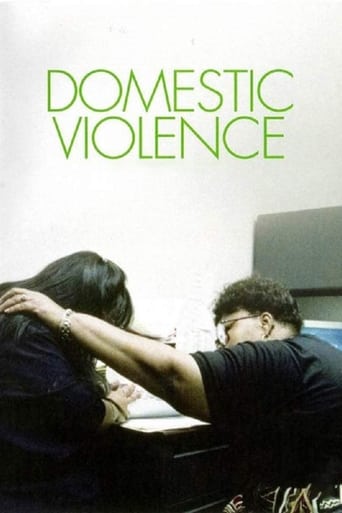

The 3hr 16min film opens with a police car cruising through the streets, arriving at a domestic disturbance and arresting a man who claims innocence. It goes on after this to show a mixture of arrests and questioning in households which have reported domestic disturbance. A large part of this important documentary also consists of women in group sessions and discussion with counselors in a shelter for battered victims. Bruised and angry women (many of whom have small children) recount their horrific pasts of sexual, emotional and physical control. Interestingly enough, the main reason the women gave for eventually leaving the batterer (usually a husband or boyfriend) and coming to the refuge for help, was not to protect themselves, but to protect their children.The most positive thing about the film was how the victims eyes were opened to their own self-worth at the refuge. A lot of the women reported that they didn't even realize that what their partners were doing was wrong, and if they did, they forgave them and let them do it again and again. There is a tragic scene early in the film where are blood-soaked woman whose teeth have been punched through her cheek screams for the paramedics not to take her away.Statistics showed that 650 adults and one thousand children arrive at the shelter annually. 50% of these children have been abused prior to admission and 50% of which are under 5yrs old. 15% of batterers are women and about 12 men each year go to the refuge for help. Domestic violence crimes take up a third of all police time, (Tampa, Florida).Each different story/clip is separated by drab images of six-lane traffic and the desolate buildings of the shelter, I don't think the sun was shown once.Domestic Violence is an excellent reminder of the cruelty a large proportion of the population still has to live with from day to day and and cyclic nature of family abuse. Despite the depressive nature of the material, it is both real and hope-giving.
... View MoreIt just struck me where I'd seen this film before and it wasn't a film. It was a newspaper article and it involved interviews with abused prostitutes. The interviewer quoted a figure of 95% when she talked about the number who had been abused. But all of her data came from the shelter which was specifically set up, by the local church, to protect abused prostitutes. Non abused prostitutes avoided it.The films shot only within the walls are not enough to be disturbing. They don't cross the barrier. Or, more accurately they cross it too suddenly. OUtside are husbands, and wives, who are more interested in sex than in violence. Outside, are battered husbands who can't and wont talk about it. Outside, in the hospitals are battered men. For every woman who is bashed by a man, for any reason, something like twenty men are also bashed by other men.The film talks about these women discovering their self worth only in the refuges. It doesn't cover the reasons for the womens lack of self worth before that. Modern women do not live in fishbowls. They are out and about like everyone else. Why do they only discover self worth in these places.???Too limited. The film also needs to be slotted into the whole picture of society in general.
... View MoreIf you are familiar with Wiseman you know what to expect. I found myselffascinated by all 196 minutes of this film. Two or three times during the film we see a tour group of elderly women who are visiting the battered women'sshelter/rehabilitation center/school where the majority of the film takes place. These old women are spectators in this bizarre and frightening world just as we are. The expressions on their faces - the various ohs and oohs, the cowls, the frowns and the nods of supposed understanding - mimic those of the audience.The old women are helpless tourists who wonder exactly what it is they can do to help, and the task seems so overwhelming that they're left to sit at a board room table and sip iced tea. Wiseman's observational camera is the perfectmedium with which to view domestic violence, a problem that has probablyalways existed and will continue to exist as long as we do. Here is, in three hours and sixteen minutes, its document. A multi-angled and wholly satisfying portrayal. Highly recommended.
... View MoreDomestic Violence was a documentary feature entry in the most recent Chicago International Film Festival. The director had his camera witness things as they were going along. There are no interviews and no recreations. The subjects of the documentary were abused women who are welcomed into a shelter in Florida, and we are introduced to them through the registry process, assignment of housing and counseling sessions, as well as the generous staff who run the shelter and provide comfort. To watch these survivors pick themselves up and try to go forward with their lives, especially those who have children, is dramatic, and hopeful, and heartbreaking. All audience members will have specific dialogue bits reach them personally, whatever they may be, especially audience members who had experienced mental, emotional or physical abuse. Ideas take up entire scenes, but one or two simple sentences uttered by the film's participants can become so profound to the viewer. Documentary films can be just as powerful, dramatic, shocking, inspired, educational and even entertaining as their fictional counterparts, and "Domestic Violence" provides the viewer with an emotional roller coaster. The director has shown that the effects of abuse on other people, especially those that so loved their abusers, can have far-reaching effects (the abused finally leave their abusers, fine, but they are far from done with what has happened). This is an excellent documentary film that deserves to be seen.
... View More